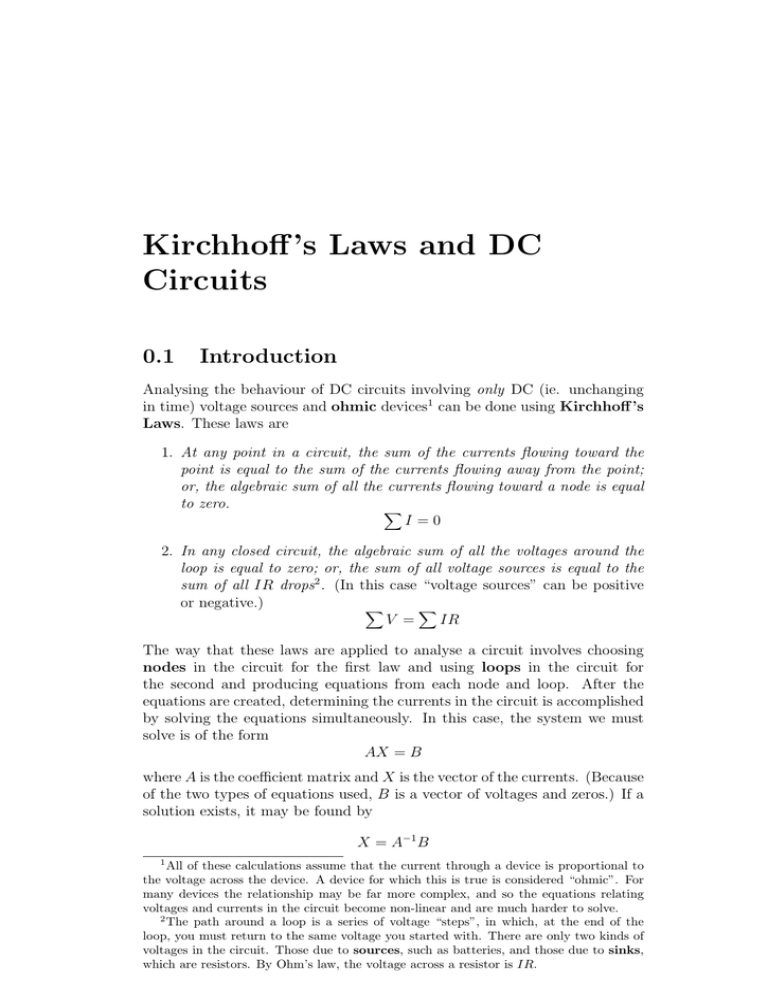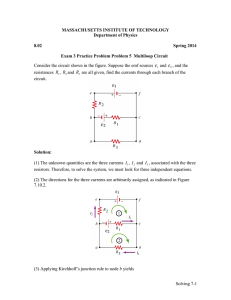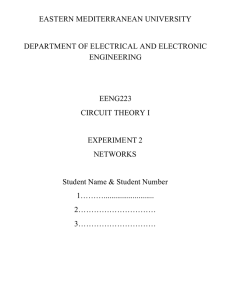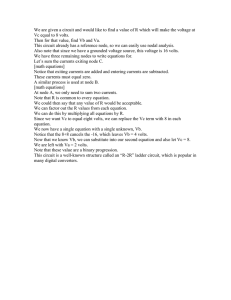Kirchhoff`s Laws and DC Circuits
advertisement

Kirchhoff ’s Laws and DC Circuits 0.1 Introduction Analysing the behaviour of DC circuits involving only DC (ie. unchanging in time) voltage sources and ohmic devices1 can be done using Kirchhoff ’s Laws. These laws are 1. At any point in a circuit, the sum of the currents flowing toward the point is equal to the sum of the currents flowing away from the point; or, the algebraic sum of all the currents flowing toward a node is equal to zero. X I=0 2. In any closed circuit, the algebraic sum of all the voltages around the loop is equal to zero; or, the sum of all voltage sources is equal to the sum of all IR drops2 . (In this case “voltage sources” can be positive or negative.) X X V = IR The way that these laws are applied to analyse a circuit involves choosing nodes in the circuit for the first law and using loops in the circuit for the second and producing equations from each node and loop. After the equations are created, determining the currents in the circuit is accomplished by solving the equations simultaneously. In this case, the system we must solve is of the form AX = B where A is the coefficient matrix and X is the vector of the currents. (Because of the two types of equations used, B is a vector of voltages and zeros.) If a solution exists, it may be found by X = A−1 B 1 All of these calculations assume that the current through a device is proportional to the voltage across the device. A device for which this is true is considered “ohmic”. For many devices the relationship may be far more complex, and so the equations relating voltages and currents in the circuit become non-linear and are much harder to solve. 2 The path around a loop is a series of voltage “steps”, in which, at the end of the loop, you must return to the same voltage you started with. There are only two kinds of voltages in the circuit. Those due to sources, such as batteries, and those due to sinks, which are resistors. By Ohm’s law, the voltage across a resistor is IR. 0.2 Example 2 Figure 1: Original Circuit Figure 2: Labelled Voltages and Resistances where A−1 is the inverse of the coefficient matrix. (A solution will not exist if you have, for instance, erroneously connected two different voltage sources in parallel.) So far no mention has been made of the dimension of the coefficient matrix. Clearly, to be invertible A must be square, however you will probably have many more equations than currents. This is because the equations are not all linearly independent. In other words, some of the equations are redundant, and will have to be eliminated for the system to be solvable. 0.2 Example Consider the circuit of Fig. 1. 1. Label all V’s and R’s. (See Fig. 2) 2. Label all i’s to go with R’s and pick directions for i’s. (See Fig. 3) 3. Label loops. (See Fig. 4) 4. Label nodes. (See Fig. 5) 5. Make loop equations.For each loop: (a) Start at node, go around to first component. 0.2 Example Figure 3: Currents Labelled and Directions Chosen Figure 4: Loops Labelled Figure 5: Nodes Labelled 3 0.2 Example 4 (b) If component is a battery, count the voltage as positive if you come to the ‘-’ terminal first. (c) If component is a resistor, count the IR as positive if you come to the resistor going against the current. (d) Repeat for all components until you are back at the node. (e) Set the sum of all of the contributions from 5b and 5c to zero. Thus (for example above) Loop 1 (starting at node 1) V1 − i1 R1 + i3 R3 = 0 Loop 2 (starting at node 2) V2 − i2 R2 − i3 R3 = 0 Loop 3 (starting at node 1) V1 − i1 R1 + V2 − i2 R2 = 0 6. Make node equations.For each node: (a) Currents coming into node are positive, others are negative. (b) Set the sum of all of the contributions from 6a to zero. Thus (for example above) Node 1 i 2 − i3 − i 1 = 0 Node 2 i 1 + i3 − i 2 = 0 7. Set up a system of equations. Thus (for example above) Loop 1 : −i1 R1 Loop 2 : Loop 3 : −i1 R1 N ode 1 : −i1 N ode 2 : +i1 −i2 R2 −i2 R2 +i2 −i2 +i3 R3 −i3 R3 −i3 +i3 = −V1 = −V2 = −V1 − V2 = 0 = 0 8. Create matrices. Thus (for example above) we can rewrite the above system in matrix form as −R1 0 +R3 −V1 0 −R2 −R3 −V2 i1 −R1 −R2 0 i2 = −V1 − V2 −1 +1 −1 i3 0 +1 −1 +1 0 0.2 Example 5 so clearly if we let −R1 0 −R1 A= −1 +1 0 −R2 −R2 +1 −1 and +R3 −R3 0 −1 +1 i1 X = i2 i3 and −V1 −V2 B = −V1 − V2 0 0 then AX = B 9. Reduce coefficient matrix to square. (Since it will not be invertible otherwise.) Be sure to adjust the solution vector accordingly. Thus in example above note that row3 = row1 + row2 therefore delete row3 and also row5 = −row4 therefore delete row5 and so we are left with −R1 A= 0 −1 and 0 −R2 +1 +R3 −R3 −1 −V1 B = −V2 0 10. Solve the system. Now X = A−1 B which gives R3 V1 + R3 V2 + R2 V1 1 X= R3 V1 + R1 V2 + R3 V2 R2 R1 + R2 R3 + R1 R3 R1 V2 − R2 V1 Notice that, depending on the voltages involved, some of the currents could be negative. In this case, it simply means that the actual current goes in the opposite direction from what you had chosen.




